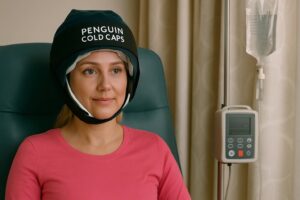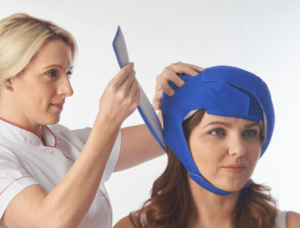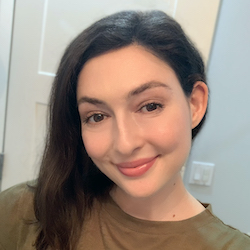Abraxane and Hair Loss: Can cold capping help you keep your hair?
Published: June 23, 2025

If you’ve just learned you’ll be starting chemotherapy with Abraxane (nab-paclitaxel), you might be feeling a mix of emotions – anxiety, disbelief, courage, or even just numbness. Breathe. Whatever you’re feeling is completely okay.
A cancer diagnosis flips your world upside down. Suddenly, you’re learning new medical terms, juggling appointments, and making decisions you never imagined you’d face.
And quietly, one question may be on your mind: “Will I lose my hair?”
Hair loss often feels deeply personal. It’s not just about how you look – it’s about how you feel, how you’re seen, and how much control you have.
If that’s how you’re feeling, you are absolutely not alone. And most importantly, there are choices you can make.
Let’s go through this together. You deserve clarity, confidence, and compassion.
In this article, we’ll cover:
- What is Abraxane (nab-paclitaxel)?
- How does Abraxane work?
- What to expect during treatment?
- Hair loss on Abraxane: What you should know
- What is cold capping?
- Does cold capping work with Abraxane?
- What it feels like to cold cap
- Clinical evidence supporting Penguin Cold Caps
- Real patient experiences
- Frequently asked questions about Abraxane & cold capping
- Find a support network
What is Abraxane (nab-paclitaxel), and why is it prescribed?
Abraxane is a chemotherapy drug made by combining paclitaxel with a human protein called albumin, which helps the drug travel more easily through your bloodstream. It’s commonly prescribed for:
- Metastatic breast cancer (often if other taxanes cause allergic reactions)
- Advanced pancreatic cancer (alongside gemcitabine)
- Non-small cell lung cancer
Your oncologist may have chosen Abraxane because it offers a powerful alternative, especially if you’ve previously had allergic reactions to paclitaxel or docetaxel.
How does Abraxane work?
Abraxane works by blocking the ability of cancer cells to divide and grow. It targets microtubules, key structures that help cells split into two. By disrupting this process, the drug helps stop cancer progression.
Unfortunately, it doesn’t just affect cancer cells. It also targets healthy, fast-growing cells like the ones in your hair follicles. That’s why hair loss is such a common side effect.
What to expect during treatment
How you’ll receive it
Abraxane is typically administered through an IV line, either in your arm or via a central line like a PICC, portacath, or Hickman line—depending on your treatment plan.
Cycle schedules:
• Breast cancer: Given once every 3 weeks.
• Pancreatic cancer: Given weekly for 3 weeks, followed by a one-week break.
Pre-treatment & monitoring
You’ll have regular blood tests before and during treatment to monitor your blood cell counts and organ function. Unlike some other taxanes, Abraxane usually doesn’t require pre-medications for allergic reactions.
Common side effects include:
- Hair loss (often full scalp and body)
- Fatigue and weakness
- Neuropathy (tingling in fingers or toes)
- Low white and red blood cells (risk of infection, anaemia)
- Mouth sores
- Nausea or loss of appetite
- Constipation or diarrhoea
- Rash or dry, itchy skin
- Aches in joints and muscles
Rarely, Abraxane can cause more serious effects like allergic reactions, blood clots, or liver swelling. Your care team will help you manage side effects—never hesitate to reach out.
Hair loss on Abraxane: What you should know
Hair loss typically begins 2–3 weeks after your first treatment. For many, it includes scalp hair, eyebrows, eyelashes, and sometimes body hair.
It’s okay to feel emotional about it. For some, it represents:
- Privacy – Wanting to keep your diagnosis to yourself
- Identity – Feeling connected to your femininity, personality, or sense of self
- Control – Needing something tangible to manage in a world of unpredictability
There’s a way to take back a bit of that control: cold capping.
What is Cold Capping?

Cold capping (or scalp cooling) is a technique that helps reduce hair loss during chemotherapy. The cap chills the scalp before, during, and after treatment, reducing blood flow and limiting how much of the drug reaches hair follicles.
Penguin Cold Caps customizes its protocol for your specific regimen, including Abraxane—and supports you every step of the way.
For more on cold capping: What is cold capping?
Does Cold Capping work with Abraxane?
Yes, and especially when started with your very first infusion.
Patient experiences and studies show that many people keep 50–80% or more of their hair on chemo, depending on regimen, dose, frequency, and how strictly they follow the cooling protocol.
Why it works:
- Vasoconstriction: The cold causes scalp blood vessels to shrink, limiting chemo delivery.
- Lower absorption: Less chemo reaches the hair follicles.
- Hair preservation: Reduced drug exposure means less follicle damage.
You may still experience some shedding, but many patients retain enough hair to feel more like themselves. That alone can be incredibly empowering.
Want to learn more? Read our article: Will cold capping save my hair on chemo?
What it feels like to Cold Cap
- Before Chemo: Wear the cap for about 50 minutes.
- During Chemo: Keep the cap on during your infusion.
- After Chemo: Continue for another 90–120 minutes.
The first 10–15 minutes can feel like a strong brain freeze, but most people adjust quickly. Blankets, warm drinks, and support from your care team can make it more comfortable.
Penguin Cold Caps provides one-on-one training, local reps, and resources to help you succeed.
To find out more, see: What does it really feel like to cold cap?
Clinical evidence supporting Penguin Cold Caps
Research confirms that scalp cooling can significantly reduce hair loss in patients receiving taxane-based chemotherapy, including Abraxane. Studies, combined with real-life patient stories, back its effectiveness.
For more information, visit: The evidence that cold cap therapy works.
Real patient experience

Victoria’s Story
- Diagnosis: Breast cancer
- Regimen: AC / Taxol / Abraxane
- Result: Saved 65% to 70% of her hair
“For me, cold capping was worth every penny and every minute. It is a big commitment, but I feel that it was a big part of my treatment and the reason why I was able to bounce back so quickly.”
Penguin makes the process simple

Schedule a free consultation with a Penguin rep near you
If preserving your hair is important to your healing journey, cold capping is worth considering. This isn’t about vanity – it’s about dignity, confidence, and choice.
FAQs: Abraxane and Cold Capping
- Will I lose all my hair on Abraxane?
Hair loss is a common side effect of Abraxane. It often includes scalp hair, eyebrows, eyelashes, and body hair. While most people experience regrowth after treatment, a small number may notice prolonged thinning or changes in texture. - When does hair loss start?
Hair shedding typically begins 2–3 weeks after your first infusion. Noticeable thinning often occurs by the third or fourth week. - Will my hair grow back?
Yes – hair usually begins to grow back within weeks to a few months after treatment ends. Regrowth may come in softer, curlier, or a different color. - Can Abraxane cause permanent hair loss?
It’s very rare, but some patients do experience incomplete regrowth. Cold capping can help reduce this risk by protecting your hair follicles throughout treatment. - Will I lose my eyebrows and eyelashes too?
Many people do, especially later in the treatment cycle or shortly after it ends. The good news: these usually start growing back within a few months. - How does cold capping help?
Cold capping cools your scalp, which reduces blood flow to your hair follicles. That means less chemotherapy reaches them—helping to minimize hair loss. - Is cold capping effective for Abraxane?
Yes. While results vary, many people using cold caps with Abraxane keep 50–80% or more of their hair. Starting from your first treatment and following the protocol closely are key factors. - Can cold capping work with weekly Abraxane regimens?
It can. Even with more frequent doses, patients often retain significant amounts of hair when cold capping is used properly and consistently. - How long do I need to wear the cold cap?
Plan for about 50 minutes before chemo, throughout your infusion, and 90–120 minutes afterward. - Is cold capping painful?
The first 10–15 minutes can feel like a brain freeze. But most people adjust quickly, especially with blankets, hot drinks, or a neck pillow. - Can I wash my hair while cold capping?
Yes – just gently. Use lukewarm water, wait at least 48 hours post-infusion, and avoid harsh shampoos or frequent washing. - What hair care products should I use?
– Use sulfate-free, paraben-free shampoo and conditioner
– Comb gently with a wide-tooth comb
– Avoid heat styling and tight hairstyles
– Keep your hair moisturized with a lightweight leave-in conditioner
Find a support network
Undergoing Abraxane chemotherapy can be both physically and emotionally demanding. Having a strong support network can make a significant difference in your treatment experience, offering encouragement, shared experiences, and practical advice.
Support groups
Connecting with others who understand what you’re going through can be incredibly helpful. Many cancer centers offer in-person support groups, allowing you to share experiences, ask questions, and receive emotional support from people on similar treatment journeys.
Online communities
For those looking for support from the comfort of home, online forums and social
media groups provide a valuable space to connect with others undergoing chemotherapy. Groups like the Chemotherapy Support Group on Facebook or cancer-specific forums offer a platform to exchange advice, discuss side effects, and find encouragement.
Looking for inspiration? Follow our Instagram to see stories from our amazing clients who are going through their own cancer journey right now!